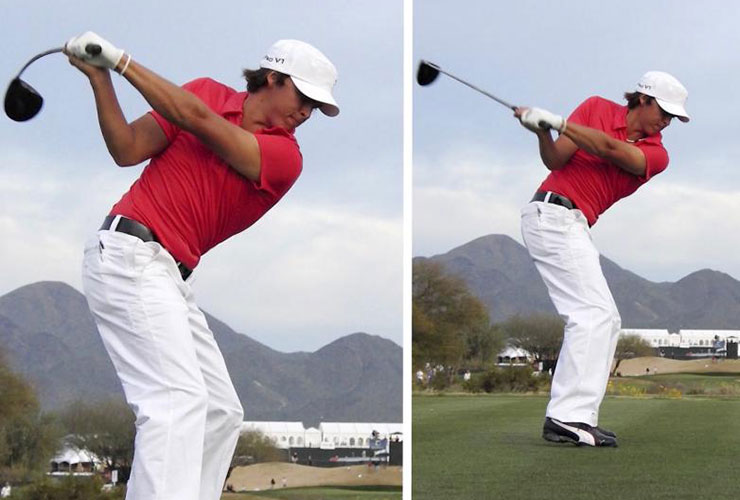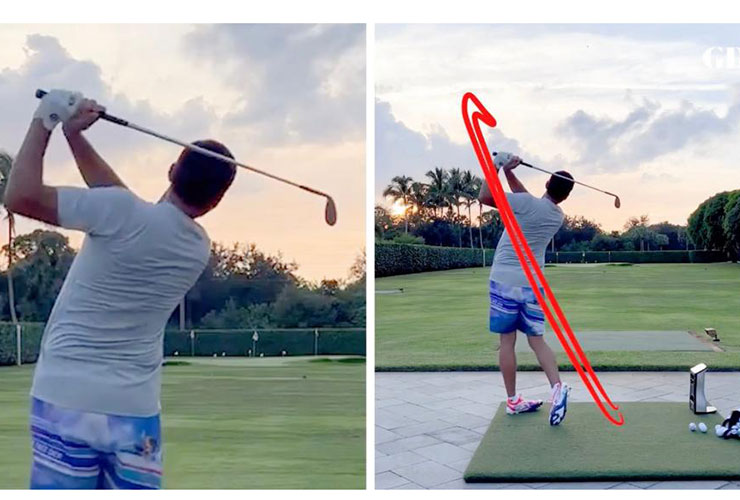Rickie Fowler is one of the most famous and popular golfers in recent history.
The story of his golf swing is a fascinating one. Because he’s an incredibly talented player. One whose career has brought him big wins, prestigious records and millions of dollars, forced to confront the same problem that so many golfers do. The problem of what feels natural, and what is most consistent, and how to balance between two.
You can watch the full video breakdown of Rickie Fowler’s swing below.
When they first take up the game, lots of junior golfers often learn to swing with clubs that are slightly too long and heavy. Rickie, a self-taught player from a middle-class town in California, almost certainly did, too.
And just like we see the effects in Brooke Henderson’s or John Daly’s long backswing. We can spot the same effects in young Rickie Fowler’s homegrown one-of-a-kind backswing too.
Perhaps the easiest way to understand what was happening in Rickie’s old move is to watch closely how the clubhead moved during his swing. The clubhead is the heaviest part of the golf club, every golfer moves it around in slightly different ways because of how they’re built.
Young Rickie starts his swing by dragging the clubhead outside his hands using the bigger muscles in his chest and torso. It gives the early part of his backswing a similar, albeit less exaggerated, look to Matthew Wolff.
But whereas Wolff uses the muscles in his arms to start lifting and tilt the club more vertically during the second part of his backswing, Fowler kept turning the club around him. It’s what gave Rickie’s old swing its recognisable flat and laid off look at the top.
Like many junior golfers, when Rickie was young, he lacked the arm strength. So instead, he just kept turning, and his arms followed the club. This caused the weight of the clubhead to drop really far behind his body, and the clubhead stayed back there even as his arms began his downswing. A bit like how the weight of the ball causes a pitcher’s arm to lag behind the rest of his body.
Over time that move became ingrained in his swing, even as he got bigger and stronger.
This process landed Rickie in what many teachers call a prototypically “stuck” position on the downswing, which is what happens when your arms get too far behind the rest of your body.
Many coaches say that when golfers get their arms ‘stuck’ so far behind them like this, they generally need to rely heavily on their hands to get the club back out in front of them quickly to avoid missing shots out to the right.
It’s something lots of good young players struggle with, including a young Tiger Woods.

It required Rickie to keep a lot of different plates spinning at the same time. If one thing went wrong, so did the others.
It’s why young Rickie tended to be a streaky ballstriker. Some years it was good, other years it was less good. When his hot putter started to cool off, that’s when his results did, too.
But that’s starting to change thanks to a some new feels that show up in his backswing, as he told Sports Illustrated earlier this year:
“For me it’s really all takeaway-based. If I get the first half of the takeaway in a good spot it kind of sets me up.”
Whereas in Rickie’s old takeaway the clubhead would move outside, he wants the club to feel more “connected” to his body, so it tracks parallel to his target line. From there, instead of rolling the club open and around him like in his old swing, Rickie wants to move the club more vertically up, towards the sky. This lands his right arm in a better spot at the top of his backswing, which helps his arms track more in front of his body on the way down.
Put simply, Rickie wants his golf swing to move more up and down, and less around. That creates, in Rickie’s own words, “cleaner lines” in his golf swing for more consistency.

The challenge now is taking that change from the range, to the course. It doesn’t always feel comfortable, Rickie says, but it’s getting better and better.
It’s a process we can all relate to. Overriding some of your natural tendencies doesn’t happen overnight, and requires a lot of hard work. And with a little more time, it won’t be long until Rickie takes his range swing to the golf course, and enjoys some great results because of it.









